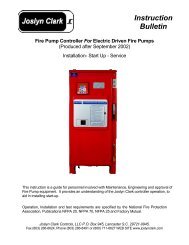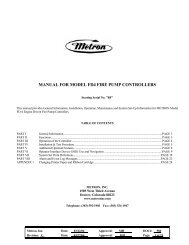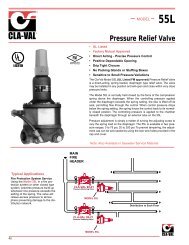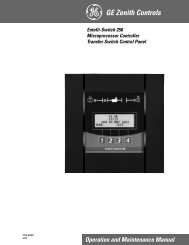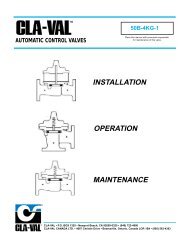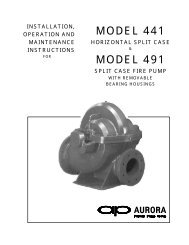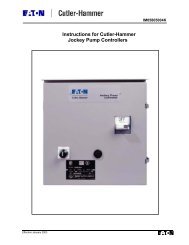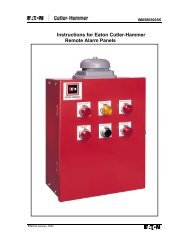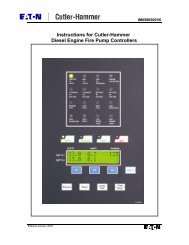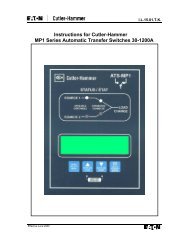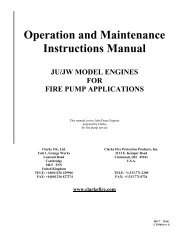U.S. Electrical Motors Installation and Maintenance Manual
U.S. Electrical Motors Installation and Maintenance Manual
U.S. Electrical Motors Installation and Maintenance Manual
Create successful ePaper yourself
Turn your PDF publications into a flip-book with our unique Google optimized e-Paper software.
U.S. <strong>Electrical</strong> <strong>Motors</strong><br />
<strong>Installation</strong> <strong>and</strong> <strong>Maintenance</strong> <strong>Manual</strong><br />
SAFETY FIRST<br />
High voltage <strong>and</strong> rotating parts can cause serious or fatal injury. Safe installation,<br />
operation, <strong>and</strong> maintenance must be performed by qualified personnel. Familiarization<br />
with <strong>and</strong> adherence to NEMA MG2, the National <strong>Electrical</strong> Code (NEC) <strong>and</strong> local<br />
codes is required. It is important to observe safety precautions to protect personnel<br />
from possible injury. Personnel should be instructed to:<br />
1. Be familiar with the equipment <strong>and</strong> read all instructions thoroughly before<br />
installing or working on equipment.<br />
2. Avoid contact with energized circuits or rotating parts.<br />
3. Disconnect all power sources before initiating any maintenance or repair.<br />
4. Act with care in accordance with prescribed procedures in h<strong>and</strong>ling <strong>and</strong><br />
lifting this equipment.<br />
5. Be sure unit is electrically grounded in accordance with code requirements.<br />
6. Be sure equipment is properly enclosed or protected to prevent access by<br />
children or other unauthorized personnel in order to prevent possible accidents.<br />
7. Be sure shaft key is fully captive before unit is energized.<br />
8. Avoid contact with capacitors until safe discharge procedures have been<br />
completed.<br />
9. Provide proper guarding for personnel against rotating parts <strong>and</strong> applications<br />
involving high inertia loads which can cause overspeed.<br />
10. Avoid extended exposure to equipment with high noise levels.<br />
INSPECTION AND HANDLING<br />
Inspect unit to make sure no damage has occurred during shipment. Check<br />
nameplate for correct speed, horsepower, voltage, Hertz, <strong>and</strong> phase for conformance<br />
with power supply <strong>and</strong> equipment. WARNING: Units should be lifted using all<br />
eyebolts or lugs if provided. These eyebolts or lugs are provided for lifting this unit<br />
only <strong>and</strong> must not be used to lift any additional weight. Lifting angle, from shank of<br />
eyebolt, must not exceed 30° for machines with single <strong>and</strong> 45° for machines with<br />
multiple lifting means. Replacement eyebolts must be per ASTM A489 or equivalent.<br />
All eyebolts must be securely tightened. Be careful not to touch overhead power<br />
lines with lifting equipment. Failure to observe this warning may result in serious<br />
personal injury.<br />
STORAGE<br />
Units should be stored indoors, in a clean, dry location & winding should be protected<br />
from excessive moisture absorption. NOTE: If motors are to be stored for more than<br />
one year, refer to U.S. <strong>Electrical</strong> <strong>Motors</strong>. If gear <strong>and</strong> belt transmission units are to be<br />
stored for more than six months, refer to U.S. <strong>Electrical</strong> <strong>Motors</strong>.<br />
LOCATION<br />
WARNING: Use only UL Listed Hazardous Location <strong>Motors</strong> for service in Hazardous<br />
Locations as defined in Article 500 of the NEC. Units should be located in a clean,<br />
well-ventilated area. WARNING: Units should be located in a suitable enclosure to<br />
prevent access by children or other unauthorized personnel to prevent possible<br />
accidents.<br />
INSTALLATION / MOUNTING<br />
Mount units on a firm, flat surface sufficiently rigid to prevent vibration. Drive belts<br />
<strong>and</strong> chains should be tensioned in accordance with supplier recommendations.<br />
Couplings should be properly aligned <strong>and</strong> balanced. For belt, chain <strong>and</strong> gear drive<br />
selection refer to the drive or equipment manufacturer. For application of drive<br />
equipment refer to applicable information in NEMA MG1.<br />
<strong>Motors</strong> have been dynamically balanced using a half key the same length as the full<br />
key shipped with the motor. If pulley keyway length is less than this length, rework<br />
long key by removing one-half of excess length between pulley <strong>and</strong> end of key to<br />
maintain balance.<br />
Do not restrict motor ventilation. Unless otherwise specified on nameplate, motor is<br />
designed for operation in accordance with NEMA MG1 “Usual Service Conditions”<br />
which states an ambient temperature range of -15°C to 40°C (5°F to 104°F). St<strong>and</strong>ard<br />
grease lubricated units are suitable for operation within this temperature range,<br />
special lubricants may be required for ambient temperatures outside of the range.<br />
NOTE: <strong>Motors</strong> operating under rated load <strong>and</strong> allowable ambient conditions may feel<br />
hot when touched; this is normal <strong>and</strong> should not be cause for concern. When in<br />
doubt, measure frame surface temperature <strong>and</strong> confer with nearest office. Enclosed<br />
motors normally have condensation drain openings. Insure that drain openings are<br />
properly located <strong>and</strong> open (plugs removed) for the motor mounting position. Drain<br />
openings should be at the lowest point of end brackets, frame housing <strong>and</strong> terminal<br />
housing when the motor is installed. This may require modification of motor to<br />
accomplish. If unit appears wet, <strong>and</strong>/or has been stored in a damp location, dry out<br />
thoroughly <strong>and</strong> check for adequate insulation resistance to ground before operating.<br />
WARNING: Guards should be provided for all exposed rotating parts to prevent<br />
possible personal injury. Keep fingers <strong>and</strong> foreign objects away from ventilation <strong>and</strong><br />
other openings. Applications involving high inertia loads may damage equipment due<br />
to motor overspeed during coast shutdown. Such applications should be referred to<br />
U.S. <strong>Electrical</strong> <strong>Motors</strong>.<br />
CAUTION: Do not force drive coupling or other equipment onto shaft, as bearing<br />
damage may result<br />
POWER SUPPLY AND CONNECTIONS<br />
The power supply must agree with values on nameplate. Terminal voltage should not<br />
vary more than ±10% of nameplate voltage at rated frequency. Unbalanced line<br />
voltage, greater than one percent, can cause overheating. Do not exceed the<br />
continuous rated load amperes on the nameplate. Starting controls <strong>and</strong> overload<br />
protection should be properly sized in accordance with the NEC <strong>and</strong> the control<br />
manufacturer’s recommendations.<br />
Motor connections should be made by following instructions on connection diagram.<br />
Determine direction of rotation before connecting driven equipment. If direction of<br />
rotation label is supplied, operate only in specified direction. Rotation may be<br />
reversed on three phase motors by interchanging any two line connections. On single<br />
phase motors, interchange leads per connection diagram on motor. Wiring of units,<br />
controls <strong>and</strong> grounding shall be in accordance with local <strong>and</strong> NEC requirements.<br />
WARNING: Failure to properly ground unit may cause serious injury to personnel.<br />
Where unexpected starting could be hazardous to personnel, do not use automatic<br />
reset starting devices.<br />
USE OF VARIABLE FREQUENCY DRIVES<br />
Electric motors can be detrimentally affected when applied with variable frequency<br />
drives (VFD’s). The non-sinusoidal waveforms of VFD’s have harmonic content which<br />
causes additional motor heating; <strong>and</strong> high voltage peaks <strong>and</strong> short rise times, which<br />
result in increased insulation stress, especially when long power cable lengths are<br />
used. Other effects of VFD’s on motor performance include reduced efficiency,<br />
increased load current, vibration <strong>and</strong> noise. St<strong>and</strong>ard motors utilized with VFD’s<br />
must be limited to those application considerations defined in NEMA MG-1 Part 30.<br />
NEMA MG-1 Part 31 defines performance <strong>and</strong> application considerations for Definite<br />
Purpose Inverter fed motors. To insure satisfactory performance <strong>and</strong> reliability, U.S.<br />
<strong>Electrical</strong> <strong>Motors</strong> offers <strong>and</strong> recommends nameplated inverter duty motor products<br />
which meet the requirements of NEMA MG-1 Part 31. The use of non-inverter duty<br />
motors may result in unsatisfactory performance or premature failure, which may not<br />
be warrantable under the Terms <strong>and</strong> Conditions of Sale. Contact your U.S. <strong>Electrical</strong><br />
<strong>Motors</strong> Field Sales Engineer for technical assistance for motor selection, applications<br />
<strong>and</strong> warranty details.<br />
10 Pin Bendix Wiring 9 Pin Sub-D Wiring<br />
Vector Blower / Encoder Connection<br />
Pin #<br />
D<br />
F<br />
A<br />
B<br />
C<br />
H<br />
J<br />
K<br />
E<br />
Function<br />
+VDC<br />
COM<br />
A<br />
B<br />
Z<br />
A'<br />
B'<br />
Z'<br />
N/C<br />
Pin #<br />
Function<br />
1 +VDC<br />
2 A<br />
3 A'<br />
4 B<br />
5 B'<br />
6 Z<br />
7 Z'<br />
8 N/C<br />
9 COM
U.S. <strong>Electrical</strong> <strong>Motors</strong><br />
<strong>Installation</strong> <strong>and</strong> <strong>Maintenance</strong> <strong>Manual</strong><br />
OIL LUBRICATION<br />
Most oil lubricated units are shipped without oil. Refer to instruction manual with unit for specific type <strong>and</strong> grade of oil to be used, change interval <strong>and</strong> level. If lubrication<br />
instructions specify synthetic oil, do not substitute. WARNING: For applications in the food <strong>and</strong> drug industry (including animal food), consult the petroleum supplier for lubricants<br />
that are acceptable to the Food & Drug Administration <strong>and</strong> other governing bodies.<br />
MAINTENANCE<br />
Inspect units at regular intervals. Keep units clean <strong>and</strong> ventilation openings clear of dust, dirt or other debris. Lubricate units per this operating instruction sheet <strong>and</strong> instruction<br />
plate on unit. Excessive lubrication may damage the unit. Do not over-grease. WARNING: Disconnect all power sources to the unit <strong>and</strong> discharge all parts which may retain<br />
an electrical charge before attempting any maintenance or repair. Screen <strong>and</strong> covers must be maintained in place when unit is in operation. Failure to observe this warning may<br />
result in personal injury.<br />
U.L. Listed <strong>Motors</strong> For Use in Hazardous Locations: Repair of these motors must be made by the manufacturer or manufacturer’s authorized service station approved to repair<br />
U.L. Listed motors. The U.L. listing applies to the electric motor only <strong>and</strong> not to the belt or gear transmissions or other devices that may be connected to the motor.<br />
GREASE LUBRICATION INSTRUCTIONS<br />
Units are prelubricated at the factory <strong>and</strong> do not require initial lubrication. Relubricating interval depends upon speed, type of bearing <strong>and</strong> service. Refer to Table 1 for<br />
suggested regreasing intervals. Operating conditions may dictate more frequent lubrications. Motor must be at rest <strong>and</strong> electrical controls should be locked open to prevent<br />
energizing while motor is being serviced. (refer to section on Safety). If motor is removed from storage, refer to storage procedures.<br />
To relubricate bearings, remove the drain plug. Inspect grease drain <strong>and</strong> remove any blockage with a mechanical probe taking care not to damage bearing. CAUTION: Under<br />
no circumstances should a mechanical probe be used while the motor is in operation. Add new grease at the grease inlet, refer to Table 1 for replenishment quantities. New<br />
grease must be compatible with grease in the motor (See Caution Note). Run the motor for 15 to 30 minutes with the drain plug removed to allow purging of any excess grease.<br />
Shut off unit <strong>and</strong> replace the drain plug. Return motor to service. CAUTION: Overgreasing can cause excessive bearing temperatures, premature lubricant breakdown<br />
<strong>and</strong> bearing failure. Care should be exercised against overgreasing.<br />
TABLE 1<br />
Recommended Grease Replenishment Quantities & Intervals<br />
(For Lubrication of Units in Service)<br />
Bearing Number - Common Bearing Number - AFBMAX Grease Lubrication Interval<br />
62XX 63XX XXBC02 XXBC03 Fl. Oz. 3600 RPM 1800 RPM 1200 RPM<br />
6203 - 6207 6303 - 6306 17 - 35 17 - 30 0.2 2 years 3 years 3 years<br />
6208 - 6212 6307 - 6309 40 - 60 35 - 45 0.4 1 year 2 years 2 years<br />
6213 - 6215 6310 - 6311 65 - 75 50 - 55 0.6 1 year 2 years 2 years<br />
6216 - 6220 6312 - 6315 80 - 100 60 - 75 1.0 6 months 1 year 2 years<br />
6221 - 6228 6316 - 6320 105 - 140 80 - 100 1.8 6 months 1 year 1 year<br />
For motors mounted vertically or in hostile environments, reduce intervals shown by 50 percent.<br />
Refer to motor nameplate for bearings provided on a specific motor. For bearings not listed in the table above, the amount of grease required may be calculated by the formula:<br />
G = 0.11 x D x B<br />
where: G = Qty of grease in fluid ounces; D = Outside diameter of bearing (inches); B = Width of bearing (inches)<br />
TABLE 2<br />
Recommended Greases<br />
THE FOLLOWING GREASES ARE INTERCHANGEABLE WITH THE GREASE AS PROVIDED IN UNITS SUPPLIED FROM FACTORY (unless stated otherwise on a<br />
lubrication nameplate provided on motor).<br />
Manufacturer Grease (NLGI No. 2)<br />
Exxon Mobil<br />
Polyrex EM<br />
Chevron USA Inc. SRI No. 2<br />
CAUTION: Greases of different bases (lithium, polyurea, clay, etc.) may not be compatible when mixed. Mixing such greases can result in reduced lubricant life <strong>and</strong> premature<br />
bearing failure. When necessary, prevent such intermixing by disassembling the motor, removing all old grease from bearings <strong>and</strong> housings (including all grease fill <strong>and</strong> drain<br />
holes). Inspect <strong>and</strong> replace damaged bearings. Fill bearing housings <strong>and</strong> bearings approximately 30% full of new grease. Remove any excess grease extending beyond the<br />
edges of the bearing races <strong>and</strong> retainers. Refer to Table 2 for recommended greases.<br />
RENEWAL PARTS & WARRANTY SERVICE<br />
When inquiring for renewal parts, call the U.S. <strong>Electrical</strong> <strong>Motors</strong> Parts Department (Memphis, Tennessee) or a Parts Stocking Distributor. For warranty service call the nearest<br />
U.S. <strong>Motors</strong> Authorized Service Station. Give them complete nameplate data including ID number, etc. Request installation & maintenance manuals by product name.<br />
REGIONAL OFFICES PHONE FAX<br />
DOMESTIC U.S. SALES (888) 637-7333 (314) 553-1101<br />
INTERNATIONAL SALES (314) 553-3185 (314) 553-2135<br />
MONTREAL, QUEBEC/CANADA (800) 361-5509 (514) 332-5912<br />
TORONTO, ONTARIO/CANADA (905) 475-4670 (905) 475-4672<br />
REGIONAL OFFICES PHONE FAX<br />
MONTERREY, MEXICO (52) 8-389-1312 (52) 8-389-1310<br />
CARACAS, VENEZUELA (58) 02-2377522 (58) 02-2329727<br />
BOGOTA, COLOMBIA (57)1- 439-5420 (57)1- 439-5417<br />
IN109-34K 11/00<br />
©2000 U.S. <strong>Electrical</strong> <strong>Motors</strong> - Prices, specifications <strong>and</strong> ratings subject to change without notice. Printed in the U.S.A



